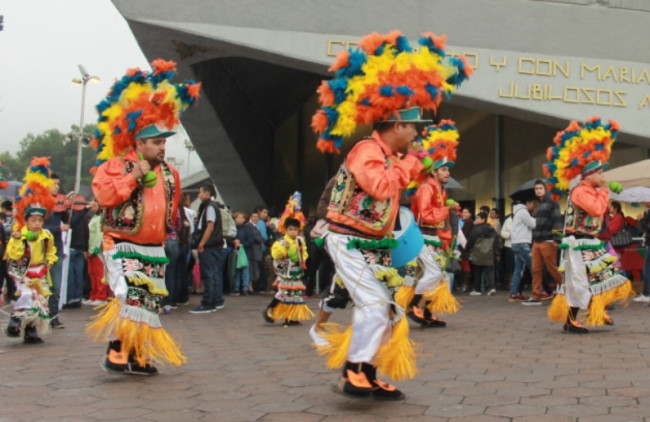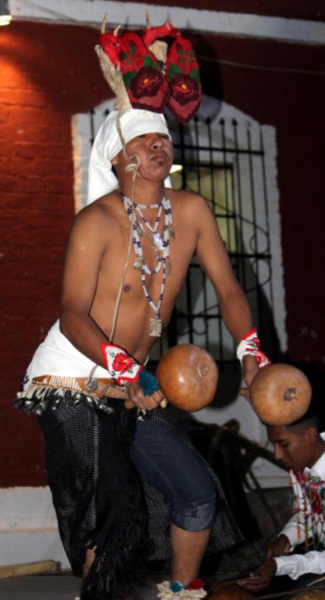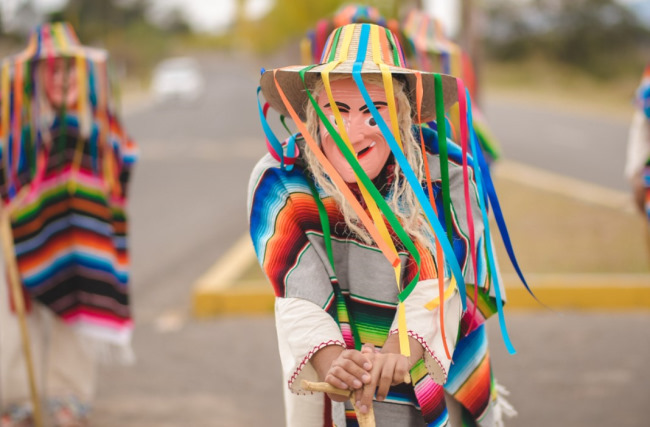Top 10 Most Popular Traditional Mexican Dance Style
Mexico doesn’t just have beautiful landscapes and great people, it also has an incredibly vibrant culture. Arguably, there’s nothing that shows off the country’s unique culture better than the many Mexican dance styles out there.
As a whole, they take inspiration from the country’s native dances, with small inspirations from African and European. You won’t see anything like it anywhere in the world!
Top 10 Most Popular Traditional Mexican Dance Styles
1. Chinelos
Chinelos is a costumed dance that’s extremely popular in the state of Morelos. So much so that it’s become a de jure symbol of the state. Despite this reputation, Chinelos originated from the southern part of Mexico City.
It is a satirical comedy in dance form. The dance is all about making fun of the Spaniard colonists who tried (and failed) to suppress indigenous dance forms long ago. Way back then, during Carnivals, people could wear masks and do things that aren’t normally accepted. That’s how Chinelos got the chance to flourish until today.
In Chinelos, dancers disguise themselves in costumes and masks. That’s how this dance got the name. The word ‘Chineros’ is said to have come from the Nahuatl word for ‘disguised’ (‘zineloquie’). Typically, dancers imitate the way that Spaniards would elaborately dress. Notably, they also wear masks with fair skin and beards.
Today, the dance style still has huge appeal. In Mexico City, Chinelos dance groups are the most popular during Carnivals. You can also see troupes dancing even outside of Carnivals. If you want to, you can even hire dancers for special occasions!
And don’t worry, although Chinelos was originally made up to make fun of Europeans, these days most people just take it as good fun.
2. Concheros
If you’re looking for an indigenous dance to feast your eyes (and ears) on, look no further than Concheros. Unlike other dance styles that you may see performed in Mexico, Concheros is mostly an indigenous dance with only minor influences from the Europeans.
Besides Concheros, the dance has many other names. The most prevalent are Huehuenches, Chichimecas, Aztecas, and Mexicanas.
Concheros came to be after the defeat of the Aztec Empire by the Spanish Empire. Although the Spanish tried their very best to wipe out all traces of indigenous culture, they didn’t succeed with Concheros. Evidence is clear: it’s still performed today.
When you watch a Concheros performance, you will see dancers attired in traditional costumes that look similar to old Aztec regalias. Each costume has various parts made from different materials and often in bright colors. These elements can be animal parts or have scenes depicted on them that relate to religion, history, war, and other aspects of Mexican culture.
The most impressive part of a Concheros dancer’s costume must be the headdress, which I can only describe as majestic.
Dancers perform on top of traditional music performed by drums, flutes, conch shells, lutes made from Armadillo shells, and more.
3. Danza de Los Diablos
For those who want a clear look at the oft-hidden African characteristic of Mexican culture, all you have to do is watch a performance of Danza de Los Diablos (‘Dance of the Devils’).
During the Spanish colonization effort of Central and South America, they brought Africans to the continent as slaves. On days that they were given freedom, the slaves went out to celebrate and dance. It was during such occasions that they resumed some of the traditions that went on pause, among which is a ritual dedicated to the Black God Ruja.
However, the Church didn’t allow them to dance to any saint or God. This is why, as an act of defiance and rebellion, they instead danced to the Devil.
And that’s how Danza de Los Diablos came to be.
In the dance, every participant dresses up and dons a mask. But among the crowd would be one dancer who acts like the Devil. This dancer will act far more elegantly than the rest.
This dance is often performed on Dia De Los Muertos (Day of the Dead) and is often likened to symbolizing the breakaway of African slaves from the Spanish planters. The dance is most popular in the Guerrero and Oaxaca region of Mexico.
4. Danza del Venado
Performances of Danza del Venado (Deer Dance) can be seen in Sonora and Sinaloa. Usually, they are performed by indigenous dance troupes, like the Yaquis and Mayos.
As its name suggests, the dance’s spirit is attributed to the deer. In it, dancers pay tribute to the enduring spirit of the deer after it’s been hunted and felled by deer hunters. The deeper meaning behind Danza del Venado is the celebration of the world’s renewal in springtime. As such, the dance is often performed during Lent or Easter.
Originally, Danza del Venado was performed by hunters the night before a hunt. It’s said to bring success to the hunting crew. These days, it’s mostly done as either performance arts or a ceremony to communicate with the spiritual world.
In performance, dancers wear a belt made from deer hooves. He holds a gourd in each of his hands and has rattles tied to his ankles. On his head, he wears a deer head (which can either be real or a replica) with red ribbons tied around the antlers, meant to symbolize flowers.
5. Danza de los Viejitos
Danza de Los Viejitos (Dance of the Old Men) is a traditional dance style associated with the state of Michoacán in Mexico.
The core of the dance is quite spiritual. Danza de los Viejitos is said to have originated from the Purépecha area in the northwestern part of Michoacán. People in this area celebrate El Dios Viejo (the Old God).
They use this dance as a means to communicate with him to ask to talk to spirits, pray for good harvests, or learn about the past and predict the far future.
A performance is made up of four danzantes (dancers). There are four because each person represents the four elements: fire, earth, air, and water. People believe four is the right number of dancers because four colors are making up a good corn stalk: red, yellow, white, and blue. Each corresponds to an element.
Like other traditional Mexican dances, the performers of Danza de Los Viejitos also wear costumes and masks. A special part of their uniforms is the sandals with wooden soles, which make a distinct clicking sound when they hit the ground during the dance.
6. Danza de los Voladores
Danza de Los Voladores (Dance of the Flyers) is a staple of the Totonicapán area in the northern parts of Veracruz and Puebla states of Mexico. The dance is said to have originated from the indigenous people of central Mexico. It eventually spread and grew in popularity throughout Mesoamerica.
Wonder why it’s called the Dance of the Flyers?
The centerpiece of a performance is a 30-foot-long pole. Four or five dancers dance around it, then proceed to climb it to the top.
From the top, four dancers would tie themselves to the pole with ropes, then launch themselves back to the ground. The fifth would remain at the top, playing the lute and drum combination.
When you watch it in person, the performance is nothing short of spectacular.
Danza de Los Voladores, according to one Totonac myth, was a ritual to ask the rain god Xipe Topec to end a devastating drought. After the ritual was performed, rains poured and the lands became fertile once more.
Other than Danza de los Voladores, this dance is also called Palo Volador (Flying Pole) and Los Voladores de Papantla (The Flyers of Papantla). The former name is a homage to the Papantla area of Veracruz, where the Totonacs – the people most commonly associated with the dance – came from.
7. Jarabe Tapatío
Among the different types of Mexican dance styles, Jarabe is probably the most well-known internationally. In English, Jarabe is often called the “Mexican Hat Dance”. This is because, in the past, the dance was performed around a sombrero placed on the floor.
In the 1980s, Jarabe was incredibly popular in Mexican high society. The dance was about courtship, as such, it’s usually performed in a pair – one woman and one man. At first, the man’s romantic advances were refused by the woman. But, by the end, he would be accepted and they would dance “happily ever after”.
Similar to other Mexican dances on this list, Jarabe performers are costumed. The man and his partners are dressed elegantly. He would be attired in the signature Mexican charro suit, while she would wear a China Poblana dress.
Jarabe Tapatío is mostly performed on Mariachi music. If you ever get the chance to visit Mexico, you will see performances in major holidays like Las Fiestas Patrias, Cinco de Mayo, and El Dieciséis de Septiembre.
Due to its popularity, Jarabe has been studied and adapted thoroughly. If you’re well-versed with the dance, you could see its influences in many modern Mexican dance styles.
8. Matachines

To the north of Mexico, around the Zacatecas area, Matachines is king (it’s also known as Matlachines). The Danza de matachines is very old, being documented as far back as 1642.
People know of this dance through the colorful costumes worn by the performers, called Buffon. The headdress is made from chicken feathers dyed to have the same colors as the Mexican national flag. They also wear dance shoes with wooden soles, like dancers who partake in Danza de Los Viejitos. The clacking sound emphasizes each move of the dancer as they flit across the stage.
Although these days, many tropes perform the Matachines for only entertainment purposes, many dancers still enter the dance for a higher purpose. Particularly, they join in the dance as veneration of either Mother Mary or Christ, God, and the Holy Trinity.
The origin of the Matachines is quite fussy. Some sources say that it came from Tlaxcala, but most experts seem to agree that it hailed from Aguascalientes.
9. Moros y Cristianos
Moros y Cristianos (Moors and Christians) isn’t an indigenous dance. It entered Mexico by way of monks in the 16th century. Nevertheless, it’s still widely performed in the country, especially in the Michoacán area.
Moros y Cristianos is often performed at big festivals, which include mock battles, negotiations, and dances.
The theme for Moros y Cristianos is the conquering campaign of the Moors against Spaniard towns with mostly Christian populations. Performers are separated into two groups, corresponding to two religions. You can tell them apart from their masks.
- Performers who act as the Moors are going to wear masks and capes with a crescent insignia.
- Those who play the Christians are also similarly dressed, but marked with a cross.
Basically, it’s a historical reenactment in dance form!
10. La Conquista
La Conquista (The Conquest) tells the story of the Spanish conquest of Mexico. Performance is more or less a play of Mexican history.
Performers enter the stage and perform as real historical figures, like the Aztec ruler Moctezuma, the conquistadors Hernán Cortés and La Malinche. You’ll also see a female performer in the role of a Nahua woman who acts as the translator and adviser to the conquistadors.
It depicts the tragic death of Moctezuma at the hands of the conquistadors.
La Conquista is quite popular in the western parts of the country, in Michoacán and Jalisco. Though it is not an indigenous dance, La Conquista functions as a way to show people the history of Mexico. It’s also a way to remember those who lived and prospered before the arrival of the Spaniards.
Final Thought
Despite much of Mexican culture and history being lost due to the Spanish Empire’s actions, the country, its people, and its culture endured. Many excellent famous Mexican dance styles (or baile Folklorico) still exist in the 21st century.
Thanks to the Internet, you can see performances of every single one of these dances online. But, if you ever get the chance, you totally should see them live. The palpable magic in the air is well worth the journey.
Which one is your favorite? Have you ever seen a performance of any of these dances before? What was it like?
Tell us in the comment section!
Source: https://citydance.org/traditional-mexican-dance-styles/









Nhận xét
Đăng nhận xét